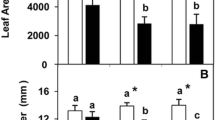Abstract
Cuttings of hybrid poplar (P.×euramericana) clone DN 17, grown in potted soil at 4 levels of P and 2 levels of Zn and/or Cu in the greenhouse, were examined for suspected P-induced micronutrient disorders. Phosphorus inhibited plant growth and caused pronounced leaf symptoms typical of nutrient disorders. Soil applications of Zn and Cu alone had no growth effect, although uptake of respective micronutrients in shoots was increased. At low phosphorus rates, Zn additions stimulated plant growth and prevented leaf symptom development; Cu supplementation, however, was not as effective as Zn. At high P rates, Zn and/or Cu restored plant growth to the control level, without completely preventing leaf symptom development, probably reflecting insufficient dosage rate to counter excessive P supply. Interpretations from foliar vector analysis indicated a primary Zn deficiency at low P treatments, and both Zn and Cu deficiencies at high P dosages. The results confirmed previous foliar diagnosis based on P-treated trees only, that excessive P fertilization may induce Zn and Cu deficiency in nursery grown hybrid poplar.
Similar content being viewed by others
References
Adams F 1980 Interactions of phosphorus with other elements in soils and in plants. In The Role of Phosphorus in Agriculture. Eds. F E Khasawneh et al. pp 655–680. Am. Soc. Agron. Crop Sci. Soc. Am., and Soil Sci. Soc. Am., Madison, WI.
Al-Showk A M, Westerman R L and Weeks D L 1987 Influence of phosphorus sources and rate on soil pH, extractable phosphorus, and DTPA-extractable micronutrients. Soil Sci. 44, 36–42.
Anderson H W 1977 Biomass production of hybrid poplar grown in minirotation. In Poplar Research, Management and Utilization in Canada. Proceedings of the North American Poplar Council Annual Meeting, Brockville, Ontario. Eds. Fayle D C F, Zsuffa L and Anderson H W. pp 11-1-11-13. Ontario Ministry of Natural Resources.
Bray R H and Kurtz L T 1945 De ermination of total organic and available forms of phosphorus in soils. Soil Sci. 59, 39–45.
Burlson C A, Dacus A D and Gerard C J 1961 the Effect of phosphorus fertilization on the zinc nutrition of several irrigated crops. Soil Sci. Soc. Am. Proc. 25, 365–368.
Fiskell J G A and Younts S E 1963 Copper status and needs in the southern region. Plant Food Rev. 9, 6–10.
Ganiron R D, Adriao D C, Paulsen G M and Murphy L S 1968 Effect of phosphorus carriers and sources on phosphorus-zinc interaction in corn. Soil Sci. Soc. Am. Proc. 33, 306–309.
Gilbey D J, Greathead K D and Gartrell J W 1970 Copper requirement for the southeastern wheatbelt. J. Agric. Western Aust. 11, 70–72.
Lindsay W L and Norvell W A 1978 Development of a DTPA test for zinc, iron, manganese, and copper. Soil Sci. Soc. Am. J. 42, 421–428.
Millikan C R 1953 Relative effects of zinc and copper deficiencies on lucerne and subterranean clover. Aust. J. Biol. Sci. 6, 164–177.
Olsen S R 1972 Micronutrient interactions. In Micronutrients in Agriculture Eds. J Mortvedt et al. pp 243–264. Soil Sci. Soc. Am., Madison, WI.
Reuter D J 1975 The recognition and correction of trace element deficiencies. In Trace Elements in Soil-Plant-Animal Systems. Eds. D J D Nicholas and A R Egan. pp 291–324. Academic Press Inc., New York.
SAS institute Inc 1985 SAS User's Guide: Statistics. SAS Institute, Inc. Cary, NC.
Smilde K W 1973 Phosphorus and micronutrient metal uptake by some tree species as affected by phosphate and lime applied to an acid sandy soil. Plant and Soil 39, 131–148.
Stone E L 1968 Micronutrients of forest tree: A review. In Forest Fertilization: Theory and Practice. Paper presented at the symposium on forest fertilization. April 1967 at Gainesville, Florida. Tenn. Valley Authority National Fertilizer Development Center. pp 132–175. Muscle Shoals, AL.
Teng Y and Timmer V R 1990a Phosphorus-induced micronutrient disorders in hybrid poplar. I. Preliminary diagnosis. Plant and Soil 126, 19–29.
Teng Y and Timmer V R 1990b Phosphorus-induced micronutrient disorders in hybrid poplar. III. Prevention and correction in nursery culture. Plant and Soil 126, 41–51.
Timmer V R 1985 Response of a hybrid poplar clone to soil acidification and liming. Can. J. Soil Sci. 65, 727–735.
Van den Burg J 1985 Foliar analysis to determine tree nutrient status-A compilation of literature data. Rijksintituut voor onderzoek in de bos-en landschapbouw ‘de Dorschamp’, Wageningen. Rapport nr. 414.
Van der Meiden H A 1962 Kopergebrek bij populier. Ned. Bosbouw Tijdschr. 34, 29–33.
Van Lear D H and Smith W H 1972 Relationship between macro- and micronutrient nutrition of slash pine on three coastal plain soils. Plant and Soil 36, 331–347.
White J W and Mastalerz J W 1966 Soil moisture as related to ‘container capacity’. J. Am. Soc. Hort. Sci. 89, 758–765.
Author information
Authors and Affiliations
Rights and permissions
About this article
Cite this article
Timmer, V.R., Teng, Y. Phosphorus-induced micronutrient disorders in hybrid poplar. Plant Soil 126, 31–39 (1990). https://doi.org/10.1007/BF00041366
Received:
Issue Date:
DOI: https://doi.org/10.1007/BF00041366




